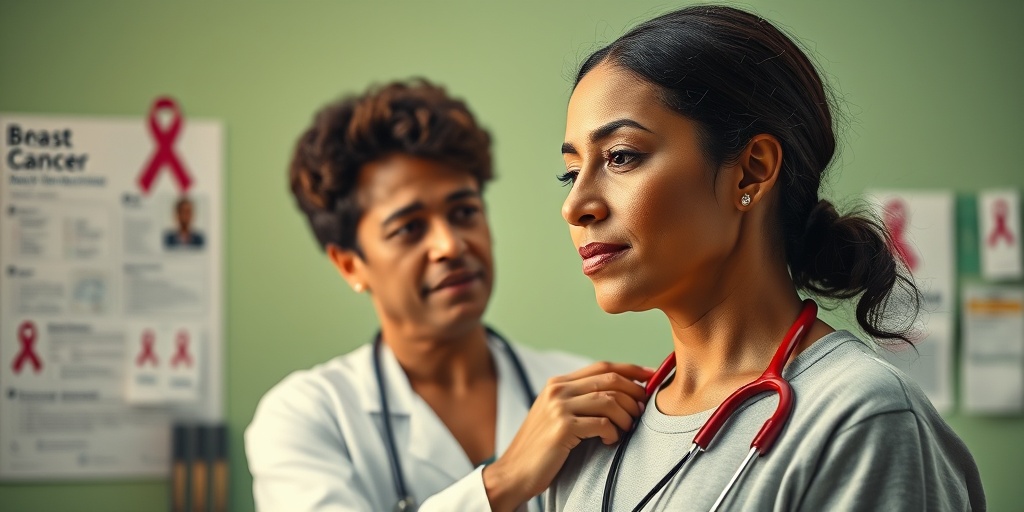What Is Breast Cancer?
Breast cancer is a type of cancer that develops in the breast tissue. It occurs when cells in the breast begin to grow uncontrollably, forming a tumor that can be felt as a lump or detected through imaging tests. While breast cancer primarily affects women, men can also develop this disease, although it is much less common.
Types of Breast Cancer
There are several types of breast cancer, with the most common being:
- Ductal Carcinoma In Situ (DCIS): A non-invasive cancer where cells inside the ducts of the breast have changed but have not spread to surrounding tissue.
- Invasive Ductal Carcinoma (IDC): The most common type, IDC starts in the breast’s milk ducts and invades nearby tissue.
- Lobular Carcinoma: This type begins in the lobules, the glands that produce milk, and can be invasive or non-invasive.
- Triple-Negative Breast Cancer: A more aggressive form that lacks three common receptors, making it harder to treat.
Understanding Breast Cancer Risk Factors
Understanding the breast cancer risk factors is crucial for early detection and prevention. Factors such as age, family history, and lifestyle choices can significantly influence an individual’s risk. For instance, women over the age of 55 are at a higher risk, and those with a family history of breast cancer may also be more susceptible.
Breast Cancer Symptoms
Recognizing the symptoms of breast cancer early can lead to more effective treatment. While some women may not experience any symptoms in the early stages, others may notice changes in their breasts. Here are some common symptoms to watch for:
Common Symptoms
- Lump or Mass: The most common sign is a lump or mass in the breast or underarm area that feels different from surrounding tissue.
- Changes in Breast Shape or Size: Any noticeable change in the shape or size of the breast can be a warning sign.
- Skin Changes: Dimpling, puckering, or redness of the breast skin can indicate underlying issues.
- Nipple Changes: Any discharge from the nipple, especially if it is bloody or occurs without squeezing, should be evaluated.
When to See a Doctor
If you notice any of these symptoms, it is essential to consult a healthcare professional promptly. Early detection is key to successful treatment. Regular screenings and self-examinations can help catch any abnormalities early on.
Utilizing Resources for Awareness
For those looking to understand more about breast cancer risk factors and symptoms, resources like Yesil Health AI provide evidence-based health answers and can guide you through the complexities of breast health.
In conclusion, being informed about breast cancer, its symptoms, and risk factors can empower individuals to take charge of their health. Regular check-ups and awareness of changes in your body are vital steps in the fight against breast cancer. Remember, knowledge is power! 💪💖

Breast Cancer Causes
Breast cancer is a complex disease influenced by a variety of factors. Understanding the breast cancer risk factors can empower individuals to make informed decisions about their health. While some risk factors are beyond our control, others can be managed or modified to reduce the likelihood of developing this disease.
Hormonal Factors
Hormones play a significant role in breast cancer development. Women who experience early menstruation (before age 12) or late menopause (after age 55) have a longer exposure to estrogen, which can increase their risk. Additionally, women who have never been pregnant or who had their first child after age 30 may also face higher risks due to prolonged estrogen exposure.
Age
Age is one of the most significant breast cancer risk factors. The risk of developing breast cancer increases as women age, with most cases diagnosed in women over 50. This correlation highlights the importance of regular screenings and awareness as one grows older.
Family History and Genetics
A family history of breast cancer can significantly elevate an individual’s risk. If a close relative, such as a mother or sister, has been diagnosed, the risk increases. Genetic mutations, particularly in the BRCA1 and BRCA2 genes, are also critical factors. Women with these mutations have a substantially higher risk of developing breast cancer compared to those without them.
Lifestyle Choices
Certain lifestyle choices can also contribute to breast cancer risk. Factors such as:
- Alcohol consumption: Studies suggest that consuming alcohol increases the risk of breast cancer. Limiting intake can be a proactive measure.
- Obesity: Being overweight, especially after menopause, is linked to a higher risk of breast cancer due to increased estrogen levels.
- Physical inactivity: Regular exercise can help maintain a healthy weight and lower estrogen levels, reducing breast cancer risk.
Radiation Exposure
Exposure to radiation, particularly during childhood or young adulthood, can increase breast cancer risk later in life. This is particularly relevant for individuals who have undergone radiation therapy for other cancers.
Genetic Risk Factors
Genetic factors play a crucial role in understanding breast cancer risk. While only a small percentage of breast cancer cases are hereditary, knowing about genetic predispositions can be vital for early detection and prevention strategies.
BRCA1 and BRCA2 Genes
The BRCA1 and BRCA2 genes are well-known for their association with breast and ovarian cancer. Women with mutations in these genes have a significantly higher risk of developing breast cancer, with estimates suggesting a lifetime risk of up to 85%. Genetic testing can help identify these mutations, allowing for proactive measures such as increased surveillance or preventive surgeries.
Other Genetic Mutations
In addition to BRCA mutations, other genetic factors can influence breast cancer risk. For instance, mutations in genes like TP53 and PTEN are also linked to increased breast cancer susceptibility. Understanding these genetic markers can help in assessing individual risk and tailoring prevention strategies.
Family History and Genetic Counseling
If breast cancer runs in your family, it may be beneficial to seek genetic counseling. A genetic counselor can provide insights into your family history and help determine if genetic testing is appropriate. This can be a crucial step in understanding your breast cancer risk factors and making informed health decisions.
Impact of Genetic Factors on Screening
For individuals with known genetic mutations, screening recommendations may differ. Enhanced screening protocols, including earlier mammograms and MRI scans, can be vital for early detection. Understanding your genetic risk can lead to a more personalized approach to breast health.
In conclusion, while some breast cancer risk factors are genetic and unchangeable, many lifestyle choices can be modified to help reduce risk. Awareness and proactive measures are key in the fight against breast cancer. 💪💖

Environmental Risk Factors
When it comes to understanding breast cancer risk factors, environmental influences play a significant role. These factors can range from exposure to certain chemicals to lifestyle choices that may increase the likelihood of developing breast cancer. Let’s explore some of the key environmental risk factors that have been identified through research.
Chemical Exposure
Many studies have pointed to the potential risks associated with exposure to various chemicals. Some of the most concerning include:
- Endocrine disruptors: These are chemicals that can interfere with hormone functions. Common sources include plastics (like BPA), pesticides, and personal care products.
- Radiation: Exposure to ionizing radiation, particularly during childhood or early adulthood, has been linked to an increased risk of breast cancer.
- Pollution: Air pollution, particularly in urban areas, has been associated with higher breast cancer rates. Studies suggest that long-term exposure to pollutants can have detrimental effects on breast tissue.
Geographical Location
Your geographical location can also influence your risk. For instance, women living in industrialized nations tend to have higher breast cancer rates compared to those in developing countries. This disparity may be attributed to differences in lifestyle, diet, and environmental exposures.
Occupational Hazards
Certain occupations may expose individuals to carcinogenic substances. For example, women working in industries that involve chemical manufacturing or radiation exposure may have an elevated risk of developing breast cancer. It’s essential for those in high-risk jobs to take preventive measures and undergo regular screenings.
Lifestyle Risk Factors
In addition to environmental factors, lifestyle choices significantly impact breast cancer risk. Understanding these can empower individuals to make informed decisions about their health. Here are some critical lifestyle risk factors to consider:
Diet and Nutrition
A balanced diet plays a crucial role in overall health and can influence breast cancer risk. Some dietary factors include:
- High-fat diets: Diets rich in saturated fats may increase the risk of breast cancer. Opting for healthier fats, such as those found in fish, nuts, and olive oil, can be beneficial.
- Alcohol consumption: Studies have shown that even moderate alcohol intake can increase breast cancer risk. Limiting alcohol to one drink per day or less is advisable.
- Obesity: Being overweight or obese, particularly after menopause, is a significant risk factor. Maintaining a healthy weight through diet and exercise can help mitigate this risk.
Physical Activity
Regular physical activity is not only essential for maintaining a healthy weight but also plays a protective role against breast cancer. Engaging in at least 150 minutes of moderate aerobic activity each week can significantly reduce risk. Activities such as walking, swimming, and cycling are excellent choices! 🚴♀️
Reproductive Factors
Several reproductive factors can influence breast cancer risk:
- Nulliparity: Women who have never given birth (nulliparous women) may have a higher risk of breast cancer compared to those who have had children. Pregnancy and breastfeeding can provide protective effects.
- Age at first menstruation: Starting menstruation at an early age can increase risk, as prolonged exposure to estrogen is a contributing factor.
- Menopause: Women who experience menopause after age 55 may have a higher risk due to extended estrogen exposure.
Smoking
While the link between smoking and breast cancer is still being studied, some research suggests that smoking may increase the risk, particularly in premenopausal women. Quitting smoking can have numerous health benefits, including potentially lowering breast cancer risk. 🚭
By understanding these breast cancer risk factors, individuals can take proactive steps towards reducing their risk. Making informed lifestyle choices and being aware of environmental influences can significantly impact overall health and well-being.

Breast Cancer Screening
Breast cancer screening is a crucial aspect of early detection and treatment. Regular screenings can significantly reduce the mortality rate associated with breast cancer by identifying the disease in its early stages when it is most treatable. Understanding the various screening methods and guidelines can empower individuals to take charge of their breast health.
What is Breast Cancer Screening?
Breast cancer screening involves tests and exams to detect breast cancer in individuals who do not have any symptoms. The primary methods of screening include:
- Mammograms: These are X-ray images of the breast that can detect tumors that are too small to be felt. Women are generally advised to start annual mammograms at age 40, but those with higher risk factors may need to begin earlier.
- Clinical Breast Exams (CBE): Conducted by a healthcare professional, a CBE involves a physical examination of the breasts to check for lumps or other changes.
- Breast Self-Exams (BSE): While not a substitute for professional screenings, self-exams can help individuals become familiar with their breast tissue and notice any changes.
Who Should Get Screened?
Screening recommendations can vary based on individual risk factors. The following groups may need to consider more frequent or earlier screenings:
- Women with a family history of breast cancer.
- Individuals with genetic mutations, such as BRCA1 or BRCA2.
- Those who have had previous breast cancer or certain non-cancerous breast diseases.
It’s essential to discuss personal risk factors with a healthcare provider to determine the most appropriate screening schedule. 🩺
Understanding the Limitations of Screening
While screening is vital, it is not foolproof. False positives and negatives can occur, leading to unnecessary anxiety or missed diagnoses. Therefore, it’s important to follow up on any abnormal results with further testing, such as ultrasounds or biopsies, to confirm a diagnosis.
Prevention Strategies
Preventing breast cancer involves a combination of lifestyle choices and awareness of risk factors. While not all breast cancer cases can be prevented, certain strategies can significantly reduce the risk.
Healthy Lifestyle Choices
Adopting a healthy lifestyle can play a pivotal role in lowering breast cancer risk. Here are some effective strategies:
- Maintain a Healthy Weight: Obesity is linked to an increased risk of breast cancer, especially after menopause. Aim for a balanced diet rich in fruits, vegetables, whole grains, and lean proteins.
- Regular Physical Activity: Engaging in at least 150 minutes of moderate aerobic activity each week can help maintain a healthy weight and reduce cancer risk.
- Limit Alcohol Consumption: Studies suggest that consuming more than one alcoholic drink per day may increase breast cancer risk. Moderation is key! 🍷
Understanding Risk Factors
Being aware of breast cancer risk factors can help individuals make informed decisions about their health. Some common risk factors include:
- Age: The risk of breast cancer increases as women age, particularly after 55.
- Genetics: Family history and genetic mutations can significantly elevate risk.
- Nulliparity: Women who have never given birth may have a higher risk compared to those who have.
Regular Check-ups and Genetic Testing
For those with a family history of breast cancer, genetic testing can provide valuable insights into personal risk. Regular check-ups with healthcare providers can also help monitor breast health and discuss any concerns regarding risk factors.
Incorporating these prevention strategies into daily life can empower individuals to take proactive steps toward reducing their breast cancer risk. Remember, knowledge is power! 💪

Frequently Asked Questions about Breast Cancer Risk Factors
What are the main breast cancer risk factors?
The primary breast cancer risk factors include:
- Age: The risk increases as you get older.
- Family History: Having close relatives with breast cancer can elevate your risk.
- Genetic Mutations: Certain inherited mutations, such as BRCA1 and BRCA2, significantly increase risk.
- Hormonal Factors: Early menstruation and late menopause can contribute to higher risk.
- Nulliparity: Women who have never given birth may have a higher risk.
How can I assess my breast cancer risk?
You can use a breast cancer risk factors calculator to evaluate your personal risk based on various factors such as age, family history, and lifestyle choices. Consulting with a healthcare professional can also provide personalized insights.
Are there lifestyle changes that can reduce breast cancer risk?
Yes! Making certain lifestyle changes can help lower your risk of breast cancer. Consider the following:
- Maintain a Healthy Weight: Obesity is linked to an increased risk.
- Regular Exercise: Staying active can help reduce risk.
- Limit Alcohol Consumption: Reducing alcohol intake may lower risk.
- Healthy Diet: A balanced diet rich in fruits, vegetables, and whole grains is beneficial.
What is the significance of age in breast cancer risk?
Age is one of the most significant risk factors for breast cancer. The likelihood of developing breast cancer increases as women age, particularly after the age of 50. Regular screenings and awareness of changes in breast health become increasingly important as you get older.
Where can I find more information on breast cancer risk factors?
For comprehensive information, you can refer to reputable sources such as:
What are some common misconceptions about breast cancer risk factors?
Many people believe that breast cancer only affects women with a family history of the disease. However, breast cancer risk factors can affect anyone, and many women diagnosed have no family history. It’s essential to be aware of all potential risk factors and not rely solely on family history.
Can I still get breast cancer if I have no risk factors?
Yes, it is possible to develop breast cancer even if you have no known breast cancer risk factors. While certain factors can increase your risk, breast cancer can occur in individuals without any identifiable risk factors. Regular screenings and being vigilant about breast health are crucial for early detection.




